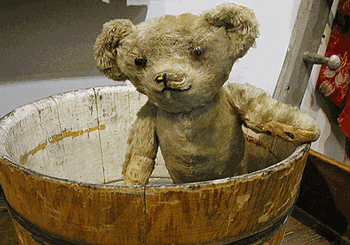featured item
Family Heirlooms
Posted by Bob Brooke on 05/04/2017
ANTIQUES EXTRA!
A Place forHeirlooms
by Bob Brooke
According to the Oxford University Press Dictionary, an heirloom is an object that has belonged to a family for several generations. Thus, all heirlooms are naturally considered antiques. Today’s 30s-somethings seem to consider these not something to treasure, but instead, they rather furnish their homes with items from IKEA and Wayfair.com. What they don’t realize is that heirlooms, no matter how trivial, are their connection to the past—to their family’s past.
For some people, a box or two of old photographs are all they have left of their family’s history. It’s not until they get older—usually when they retire—that they realize that they don’t know anything about their history. It’s only then that they scramble to recover whatever they can to learn about their ancestors.
Heirlooms, whether valuable antiques or more modest items, add warmth, nostalgia, and personalization to a home’s decor. They’re what distinguish your home from every other home on the street. In today’s McMansion communities, it’s usually what’s inside each home that says anything about the occupants. Landscaping and other restrictions imposed by the community association prevent homeowners from drastically changing the exterior of their properties.
Martha Stewart more or less became a design spokesperson for modern families. She’s done just about as much for home decor as Charles Eastlake did back the 1870s and 1880s. Stewart has always recommended using heirlooms and antiques in her decorating schemes and often sets collecting trends using them. Most design magazines use heirlooms as accents or as a focal point because they realize the importance of antiques in making an interior warm and inviting as well as adding personality to the rooms.
Start your decorating scheme with your family heirlooms and other memorable objects. These don’t have to be generations old but may just have belonged to your parents or grandparents. A 1950s “period” pie crust table may mean more to you as a parlor table from 1850. The difference is that the former belonged to someone close to you—someone you loved and cherished.
Many modern interiors, with less woodwork and starker lines, cry out for the warmth and personality of antiques. Heirlooms can be the focal point, enhancing an open stairwell, a lofted ceiling or an arched window. The beauty of heirlooms is that any home can accommodate them.
Eclectic is the keyword in today's decorating world. You can bring the past and present together in an "eclectic" setting. To intertwine the old with the new gives a room a feeling of depth and character. It’s boring to decorate with just only one style, wood, or color. Variety is the spice of life and antiques can add that spice to your decorating scheme.
Interior designers used to want everything in a room to match. Some who work for furniture retailers still practice this concept. After all, their main job is to make sure the customer buys everything they need to decorate a room from that retailer. And people who don’t feel confident about decorating accept their choices and room arrangements. In some cases, the customer doesn’t add anything personal to the mix because it could take away from the overall new look.
You’d think that younger homeowners are also looking for value, so they’d be drawn to older pieces because of their craftsmanship and warmth. But according to recent retail statistics, this isn’t the case. Many don’t realize that antiques can be a bargain in the long run. But they see antiques as representing what their parents had and want to strike out on their own.
So how do you incorporate heirlooms into your home? The trick is to group like items together, such as a grouping of candlesticks or old photographs. Color livens up a room. Use it as an accent.
You may also want to decorate individual rooms in your home around a theme. One could be based on souvenirs gathered from your family’s travels. Today’s den is just the place for a collection of souvenirs. You can use other rooms to display items used in the same rooms in your parents’ or grandparents’ houses. Dining rooms are a good place to show off heirloom china, for example.
Display should inspire your creativity. Enjoy showing off that special heirloom. Give it prominence in your display. You can be formal with a symmetrical display or informal with an asymmetrical display. In a symmetrical display, all the items are of equal balance. An example would be a lamp on each side of a fireplace mantel with an antique clock in the center. However, more people like asymmetrical displays because they involve a grouping of odd-numbered items, such as three, five, nine, etc.
Learn from the past. If you want to achieve a certain historic look, visit historic houses and museums to get an idea of what types of objects and furniture you should include. And if there’s an annual open-house tour in your or a nearby community, take the tour and pay attention to how other people use heirlooms in their homes.
And finally, study old photos, especially ones from your family. They’ll give you a historic record of real antique settings so that you can display your items in an aesthetic manner similar to your grandparents’.





